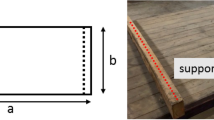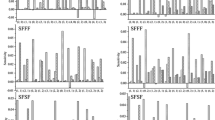Abstract
Purpose
Experimental modal analysis, a non-destructive test method, may be used to evaluate the mechanical characteristics of wood components. Equipment for data collecting and processing was a crucial element. Commercial equipment was complicated and pricey; therefore, it could not satisfy the needs of widespread use. As a result, a simple and affordable equipment design for timber vibration examination was practical and useful.
Methods
DC power, sensor current supply port, digital control amplifier, embedded microchip, and computer analysis software made up the apparatus. A function generator was used to calibrate the equipment’s sampling accuracy, which took signal frequency and voltage into account. This apparatus, which is connected to computer, impulse hammer, and accelerometer, was used to evaluate the transverse vibration of timber beams with single layer and composite layer-up. Mid-span modal tests were carried out on some single and composite beams under the condition of approximate simply supported beam. The device recorded vibration data, and estimated the modal frequency response function (FRF) to determine the fundamental frequency by Python-programmed analytical software. Using the equation for beam vibration frequency, the dynamic bending stiffness (EI) was calculated for the provided parameters, which included natural frequency, beam diameter, and weight. Four-point tests were used to calculate the specimens' static EI. Coefficients curves of dynamic and static EI were plotted.
Results
The equipment’s accuracy of AD conversion passed the beam vibration test, proving that dynamic and static EI have a positive correlation.
Conclusions
This inexpensive device can carry out non-destructive testing (NDT) assessment of wood beam EI when paired with modal tests. By providing an easy-to-use interface for measurement data access, specialized intelligent equipment utilized for structural features detection with AI models will improve this equipment.









Similar content being viewed by others
Availability of Data and Material
The datasets generated during and/or analysed during the current study are available from the corresponding author on reasonable request.
References
Hu LJ, Chui YH, Onysko DM (2001) Vibration serviceability of timber floors in residential construction. Prog Struct Mat Eng 3(3):228–237
Weckendorf J, Toratti T, Smith I, Tannert T (2016) Vibration serviceability performance of timber floors. Eur J Wood Wood Prod 74(3):353–367
Ussher E, Arjomandi K, Smith I (2022) Status of vibration serviceability design methods for lightweight timber floors. J Build Eng. 50:104111
Jarnero K, Brandt A, Olsson A (2015) Vibration properties of a timber floor assessed in laboratory and during construction. Eng Struct 82:44–54
Van Damme B, Schoenwald S, Zemp A (2017) Modeling the bending vibration of cross-laminated timber beams. Eur J Wood Wood Prod 75(6):985–994
Zingoni A (2005) On the symmetries and vibration modes of layered space grids. Eng Struct 27(4):629–638
Zhang P, Fan WY, Chen Y, Feng J, Sareh P (2022) Structural symmetry recognition in planar structures using convolutional neural networks. Eng Struct 260:114227
Fan WY, Chen Y, Li JQ, Sun Y, Feng J, Hassanin H, Sareh P (2021) Machine learning applied to the design and inspection of reinforced concrete bridges: resilient methods and emerging applications. Structures 33:3954–3963
Avci O, Abdeljaber O, Kiranyaz S, Hussein M, Gabbouj M, Inman DJ (2021) A review of vibration-based damage detection in civil structures: from traditional methods to machine learning and deep learning applications. Mech Syst Signal Pr 147:107077
Sun L, Shang Z, Xia Y, Bhowmick S, Nagarajaiah S (2020) Review of bridge structural health monitoring aided by big data and artificial intelligence: from condition assessment to damage detection. J Struct Eng 146(5):04020073
Data acquisition systems. Available online: https://www.bksv.com/en/instruments/daq-data-acquisition (Accessed on 26 Apr 2022).
Maximal testing freedom with a handheld solution. Available online: https://www.plm.automation.siemens.com/global/en/products/simcenter/scadas-xs.html (Accessed on 16 Aug 2022).
You GL, Wang BZ, Li JL, Chen AN, Sun JP (2022) The prediction of MOE of bamboo-wood composites by ANN models based on the non-destructive vibration testing. J Build Eng. 59:105078
Sound and vibration category. Available online: https://www.ni.com/en-ca/shop/hardware/sound-and-vibration-category.html# (Accessed on 14 Apr 2022).
Kouroussis G, Ben Fekih L, Descamps T (2017) Assessment of timber element mechanical properties using experimental modal analysis. Constr Build Mater 134:254–261
Guan C, Zhang HJ, Wang XP, Miao H, Zhou LJ, Liu FL (2017) Experimental and theoretical modal analysis of full-sized wood composite panels supported on four nodes. Materials 10(6):683
Zhang L, Tiemann A, Zhang TH, Gauthier T, Hsu KV, Mahamid M, Moniruzzaman PK, Ozevin D (2021) Nondestructive assessment of cross-laminated timber using non-contact transverse vibration and ultrasonic testing. Eur J Wood Wood Prod 79(2):335–347
Zhang SG, Zhou JH, Chui YH (2021) Simultaneous evaluation of bending and shear stiffness of wood I-joists by transverse vibration tests. Eng Struct 243:112643
Chui YH, Smith I (1990) Influence of rotatory inertia, shear deformation and support condition on natural frequencies of wooden beams. Wood Sci Technol 24(3):233–245
Ross RJ. Transverse vibration nondestructive testing using a personal computer. Madison: US Department of Agriculture, Forest Service, Forest Products Laboratory; 1991.
Wang Z, Li L, Gong M (2012) Measurement of dynamic modulus of elasticity and damping ratio of wood-based composites using the cantilever beam vibration technique. Constr Build Mater 28(1):831–834
Chui YH (1991) Simultaneous evaluation of bending and shear moduli of wood and the influence of knots on these parameters. Wood Sci Technol 25(2):125–134
Silva JMM (2001) Encyclopedia of vibration-measurement techniques. In: Braun S (ed) Encyclopedia of vibration. Elsevier, Oxford, pp 813–820
Zhou JH, Chui YH, Gong M, Hu L (2016) Simultaneous measurement of elastic constants of full-size engineered wood-based panels by modal testing. Holzforschung 70(7):673–682
LM134/LM234/LM334 3-Terminal adjustable current sources. Available online: https://www.ti.com/product/LM334 (Accessed on 20 Jun 2013).
General purpose ceramic shear ICP Accelerometer Installation and Operating Manual. Available online: https://www.pcb.com/products?m=352c04 (Accessed on 03 Sept 2007).
Greenspon JE (2003) Acoustics, linear. In: Meyers RA (ed) Encyclopedia of physical science and technology, 3rd edn. Academic Press, New York, pp 129–167
Radeş M (2001) Displays of vibration properties. In: Braun S (ed) Encyclopedia of vibration. Elsevier, Oxford, pp 413–431
Showcase of the package pyFRF. Available online: https://github.com/openmodal/pyFRF/blob/master/Showcase%20pyFRF.ipynb (Accessed on 18 April 2019).
Wicks AL (2001) Frequency response function estimate and coherence: part II. Exp Tech 25(5):38–40
What is a frequency response function (FRF). Available online: https://community.sw.siemens.com/s/article/what-is-a-frequency-response-function-frf (Accessed on 10 July 2020).
US-ASTM. Standard test methods for nondestructive evaluation of the stiffness of wood and wood-based materials using transverse vibration or stress wave propagation. In. West Conshohocken: ASTM international; 2021.
US-ASTM. Standard test methods of static tests of lumber in structural sizes. In. West Conshohocken: ASTM international; 2022. p. 29.
Using Digital Potentiometers for Programmable Amplifier Gain. Available online: https://www.microchip.com/en-us/application-notes/an1316# (Accessed on 24 June 2015).
Zou Y, Tong L, Steven GP (2000) Vibration-based model-dependent damage (delamination) identification and health monitoring for composite structures - a review. J Sound Vib 230(2):357–378
Green DW, Evans JW, Logan JD, Nelson WJ (2000) Adjusting modulus of elasticity of lumber for changes in temperature. For Prod J 50(3):8–8
Acknowledgements
This project was financially supported by China Scholarship Council (Grant Number: 201906865020) and Natural Sciences and Engineering Research Council through the Industrial Research Chair in Engineered Wood and Building Systems in University of Alberta. The authors would like to thank Elko Engineering Garage in University of Alberta and Alberta InnoTech.
Funding
China Scholarship Council, 201906865020, LIANG QI.
Author information
Authors and Affiliations
Corresponding author
Ethics declarations
Conflict of Interest
On behalf of all the authors, the corresponding author states that there is no conflict of interest.
Additional information
Publisher's Note
Springer Nature remains neutral with regard to jurisdictional claims in published maps and institutional affiliations.
Supplementary Information
Below is the link to the electronic supplementary material.
Rights and permissions
Springer Nature or its licensor (e.g. a society or other partner) holds exclusive rights to this article under a publishing agreement with the author(s) or other rightsholder(s); author self-archiving of the accepted manuscript version of this article is solely governed by the terms of such publishing agreement and applicable law.
About this article
Cite this article
Qi, L., Zhang, L., Zhao, M.C. et al. Low-Cost Design of Vibration Inspection Equipment for Timber Beam. J. Vib. Eng. Technol. 12, 481–493 (2024). https://doi.org/10.1007/s42417-023-00854-3
Received:
Revised:
Accepted:
Published:
Issue Date:
DOI: https://doi.org/10.1007/s42417-023-00854-3




